Bark beetle
A bark beetle is one of about 6,000 species in 247 genera of beetles in the subfamily Scolytinae.[1] Previously, this was considered a distinct family (Scolytidae), but is now understood to be specialized clade of the "true weevil" family (Curculionidae). Although the term "bark beetle" refers to the fact that many species feed in the inner bark (phloem) layer of trees, the subfamily also has many species with other lifestyles, including some that bore into wood, feed in fruit and seeds, or tunnel into herbaceous plants.[1] Well-known species are members of the type genus Scolytus, namely the European elm bark beetle S. multistriatus and the large elm bark beetle S. scolytus, which like the American elm bark beetle Hylurgopinus rufipes, transmit Dutch elm disease fungi (Ophiostoma). The mountain pine beetle Dendroctonus ponderosae, southern pine beetle Dendroctonus frontalis, and their near relatives are major pests of conifer forests in North America. A similarly aggressive species in Europe is the spruce ips Ips typographus. A tiny bark beetle, the coffee berry borer, Hypothenemus hampei is a major pest on coffee plantations around the world.
| Bark beetles | |
|---|---|
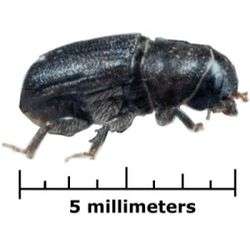 | |
| Mountain pine beetle, Dendroctonus ponderosae | |
| Scientific classification | |
| Kingdom: | Animalia |
| Phylum: | Arthropoda |
| Class: | Insecta |
| Order: | Coleoptera |
| Family: | Curculionidae |
| Subfamily: | Scolytinae Latreille, 1804 |
| Tribes | |
|
Cortylini | |
Ecology
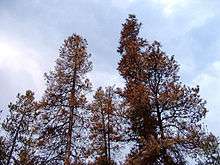
Bark beetles reproduce in the inner bark (living and dead phloem and cambium tissues) of trees. Many species, such as the mountain pine beetle (Dendroctonus ponderosae) attack and kill live trees. Most, however, live in dead, weakened, or dying hosts.[2] In undisturbed forests, bark beetles serve the purpose of hastening the recycling and decomposition of dead and dying wood and renewing the forest. A few species are aggressive and can develop large populations that invade and kill healthy trees and are therefore known as pests.
Bark beetles of the subfamily Scolytinae feed and breed between the bark and the wood of various tree species, including spruces. More than 20 species feed on weakened, dying, or dead spruce, fir, and hemlock.[3] Most restrict breeding area to one part of the tree: twig, branch, stem, or root collar. Some breed in trees of only one species, others in trees of many species.
Bark beetles often attack trees that are already weakened by disease, drought, smog, overcrowding, conspecific beetles, or physical damage. Healthy trees may put up defenses by producing sap, resin or latex, which may contain a number of insecticidal and fungicidal compounds that can kill or injure attacking insects, or simply immobilize and suffocate them with the sticky fluid.[4] Sap is one of the first line of defense of pines against bark beetles. Released sap or resins can plug bored holes of bark beetles and seals wounds. Resins also trap insect pests making some initial entry by bark beetles unsuccessful. [5] Under outbreak conditions, the sheer number of beetles can overwhelm the tree's defenses with resulting impacts on the lumber industry, water quality, fish and wildlife, and property values.[6]
According to the United States Department of Agriculture, native bark beetles can cause high levels of tree mortality in California.[7] Massive outbreaks of mountain pine beetles in western North America after about 2005 have killed millions of acres of forest from New Mexico to British Columbia.[8] Most studies of wildfire after beetle outbreaks have found no effect of beetle-caused tree mortality on wildfire size or severity.[9][10][11]
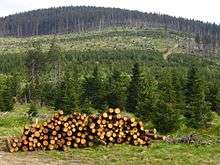
Management of bark beetle infestation in the Šumava National Park in the Czech Republic's Bohemian Forest has been controversial with some advocating non-intervention and others supporting harvesting of infested old-growth trees.[12]
Some bark beetles form a symbiotic relationship with certain Ophiostomatales fungi, and are named "ambrosia beetles" after these "ambrosia fungi". The ambrosia beetles (such as Xyleborus) feed on fungal "gardens" and are one of only three insect groups known to farm fungi. The other two groups are ants and termites, neither of which is particularly closely related to beetles. Courtesy of the fungus, ambrosia bark beetles are able to indirectly feed from many more species of trees than their evolutionary relatives that do not feed on fungi, by having the fungi do the work of overcoming the plants' chemical defenses. The beetles carry the fungal spores in special structures, called mycangia, and infect the trees as they attack them.
Like many other insects, Scolytinae emit pheromones to attract conspecifics which are thus drawn to trees already colonized by bark beetles. This can result in heavy infestations and eventually death of the tree. Many are also attracted to ethanol, one of the byproducts of microbial growth in dead woody tissues.
Gallery

Bark beetle gallery engraving the sapwood Bark beetle galleries with bark showing exit holes 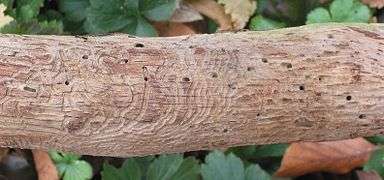
Some species produce single winding tracks Bark beetle galleries on a dead American elm - Bark beetle trap
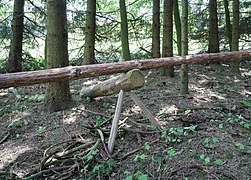
See also
- Forest pathology
- Ambrosia beetle
- Xyleborus glabratus
- Euwallacea fornicatus
- Laurel wilt disease
References
- Kirkendall, Lawrence; Biedermann, Peter H.W.; Jordal, Bjarte (2015). "Chapter 3: Bark Beetles: Biology and Ecology of Native and Invasive Species". Bark Beetles: Biology and Ecology of Native and Invasive Species. Academic Press.
- Franceschi, Vincent R.; Krokene, Paal; Christiansen, Erik; Krekling, Trygve (2005-08-01). "Anatomical and chemical defenses of conifer bark against bark beetles and other pests". New Phytologist. 167 (2): 353–376. doi:10.1111/j.1469-8137.2005.01436.x. ISSN 1469-8137. PMID 15998390.
- Rose, A.H.; Lindquist, O.H. 1985. Insects of eastern spruces, fir and, hemlock, revised edition. Gov’t Can., Can. For. Serv., Ottawa, For. Tech. Rep. 23. 159 p. (cited in Coates et al. 1994, cited orig ed 1977)
- Fettig, Christopher; Klepzig, Kier; Billings, Ronald; Munson, A. Steven; Nebeker, T. Evan; Negrόn, Jose; Nowak, John (Jan 2007). "The effectiveness of vegetation management practices for prevention and control of bark beetle infestations in coniferous forest of the western and southern United States". Forest Ecology and Management. 238 (1): 24–53. doi:10.1016/j.foreco.2006.10.011 – via Science Direct.
- Parao, M. R., Untalan, P. P., Ligat, B. S., Pagadan, C. S., & Tanguid, L. B. (2019). Damage Assessment of Bark Bettle Infestations on Benguet Pine (Pinus kesiya Royle ex Gordon) in Camp John Hay, Baguio City, Philippines. Mountain Journal of Science and Interdisciplinary Research, 79(2), 35–49. Retrieved from http://journals.bsu.edu.ph/index.php/BRJ/article/view/178/151
- Fettig, Christopher; Klepzig, Kier; Billings, Ronald; Munson, A. Steven; Nebeker, T. Evan; Negrόn, Jose; Nowak, John (Jan 2007). "The effectiveness of vegetation management practices for prevention and control of bark beetle infestations in coniferous forest of the western and southern United States". Forest Ecology and Management. 238 (1): 24–53. doi:10.1016/j.foreco.2006.10.011 – via Science Direct.
- "Bark Beetles in California Conifers Are Your Trees Susceptible" (PDF).
- Jim Robins (17 Nov 2008). "Bark Beetles Kill Millions of Acres of Trees in West". The New York Times.
- Harvey, Brian J.; Donato, Daniel C.; Romme, William H.; Turner, Monica G. (2013-11-01). "Influence of recent bark beetle outbreak on fire severity and postfire tree regeneration in montane Douglas-fir forests". Ecology. 94 (11): 2475–2486. doi:10.1890/13-0188.1. ISSN 1939-9170. PMID 24400499. S2CID 7023088.
- Meigs, Garrett W.; Campbell, John L.; Zald, Harold S. J.; Bailey, John D.; Shaw, David C.; Kennedy, Robert E. (2015-07-01). "Does wildfire likelihood increase following insect outbreaks in conifer forests?" (PDF). Ecosphere. 6 (7): art118. doi:10.1890/ES15-00037.1. ISSN 2150-8925.
- Harvey, Brian J.; Donato, Daniel C.; Turner, Monica G. (2014-10-21). "Recent mountain pine beetle outbreaks, wildfire severity, and postfire tree regeneration in the US Northern Rockies". Proceedings of the National Academy of Sciences. 111 (42): 15120–15125. doi:10.1073/pnas.1411346111. ISSN 0027-8424. PMC 4210318. PMID 25267633.
- Bláha, Jaromír; Kote˘cký, Vojtech (2015). "Spruce Bark Beetle in Šumava NP: A Precedent Case of EU Wilderness Protection, the Role of NGOs and the Public in Wilderness Protection" (PDF). USDA Forest Service Proceedings RMRS-P-74. 2015. USDA Forest Service. Retrieved August 12, 2016.
External links and further reading
| Wikimedia Commons has media related to Scolytinae. |
| Wikispecies has information related to Scolytinae |
- American and Mexican Bark and Ambrosia beetles
- Nordhaus, Hannah. Bark Beetle Outbreaks in Western North America: Causes and Consequences. University of Utah Press: Salt Lake City, 2009. ISBN 978-0-87480-965-7